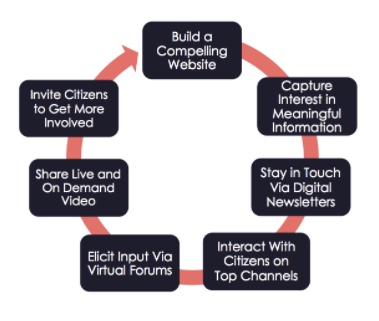In one of the first sessions of the Granicus Virtual Public Sector Digital Engagement Day, Andrew Krzmarzick, Granicus’ Vice President of Solutions Consulting, dove deep into best practices for solving some of government’s more pressing challenges.
As the world becomes increasingly digital, Krzmarzick said, government faces unique challenges in order to stay relevant and reach their target audiences. These challenges include:
- Information Overload: The average person checks their phone 47 times a day, which leads to a distracted audience. With 24-hour news, social media, and fake news, how can government cut through the daily noise to give citizens information they need?
- Distrust of Government: Public sentiment towards government is low which creates an uphill battle for public servants to achieve their missions and create better lives for more people. How are you showing that you’re being a good steward of taxpayer money?
- Outdated Tools: Agencies are often forced to work with legacy systems that can be less than efficient. PBS reported that gov is spending $80 billion just to keep aging tech running. How can you be effective and deliver better services with outdated tools?
- Limited Resources: Budgets are always scarce when compared to government organizations’ missions. How do you sustain interest in programs over time?
So how can government organizations meet their missions despite these tough challenges? It all starts with understanding the citizen engagement cycle.

The citizen engagement cycle takes into consideration different ways citizens want to connect with your organization. It helps them stay informed, participate, and even get involved with a position in government to work beside you.
Addressing the Challenges
Here are best practices, according to Krzmarzick, that can help government address its primary challenges:
- Modernize Your Website: Make it easier for citizens to navigate your organization’s website. Make sure it’s frequently updated and a true hub of information. Nobody wants to click through a ton of pages to find what they’re looking for. Civica is a website content management system (CMS) developed specifically for government to help organizations deliver more services and information to the public online.
- Capture More Subscribers: Does your website have a way for citizens to sign up for specific information as they’re browsing? Take advantage of the people who are already engaging with you so that you can keep in touch. The GovDelivery Communications Suite provides an overlay feature that captures even more subscribers than a simple email sign up page. You can also multiply your reach using the GovDelivery Network.
- Stay in Touch: Push information out to your subscribers via emails and digital newsletters. The GovDelivery Communications Cloud can help set up regular updates to your audience and even coordinate automated campaigns.
- Interact with Citizens: Engage in two-way conversations with citizens through text messaging and social media. The GovDelivery Communications Suite is the only digital communications platform helping government inform, engage, and convert 150 million citizens to action via email, text messaging and social media.
- Elicit Input: Ask citizens to provide feedback on programs and policies alike on your website or through interactive text surveys. SpeakUp is an online forum to help agencies gather input, prioritize projects and make the best decisions for their community.
- Share Videos: Go beyond written communication and create and share live and on-demand videos with citizens. These can include recorded town halls or education content. The Granicus Video solution enables your organization to build a content-rich library of public meeting webcasts and records. Leverage easy-to-use media management tools to schedule and publish live and on-demand webcasts.
- Get Them Involved: Invite citizens to get involved and apply for open board and commissions positions so they be a part of government. Granicus’ Boards and Commissions solution enables citizens to apply for boards through your website and makes it easy to manage board rosters, appointments workflows, and vacancies.
Take a moment to think about any parts of the citizen engagement cycle your organization can improve. Are you sending them information and giving them avenues to share feedback with you? Is your website an easy-to-use hub that also allows people to sign up for information they want?
Recent Success Stories
Focusing on filling in gaps of the citizen engagement cycle can have a great impact. Krzmarzick shared a few success stories of organizations across the country that are improving their communications to impact citizens’ lives. Here is a quick snapshot of the examples he provided:
- The Michigan Summer Meals Program tripled their subscribers using the GovDelivery Network and website overlays that resulted in serving almost 500,000 more meals for kids in low income areas.
- Kirkland, Washington engages their community in council meetings by sending email alerts and inviting them to share ideas to improve through text surveys and web forums.
- The Minnesota Metropolitan Council launched a new e-newsletter to keep citizens informed and to gather their feedback to inform decision-making.
- Dutchess County, New York increased their audience to keep residents informed during a snow emergency situation.
If you missed the Virtual Summit, visit the Granicus website to download the on demand webinars. If you have any questions, or want to reach out to discuss your engagement strategy, email info@granicus.com.

